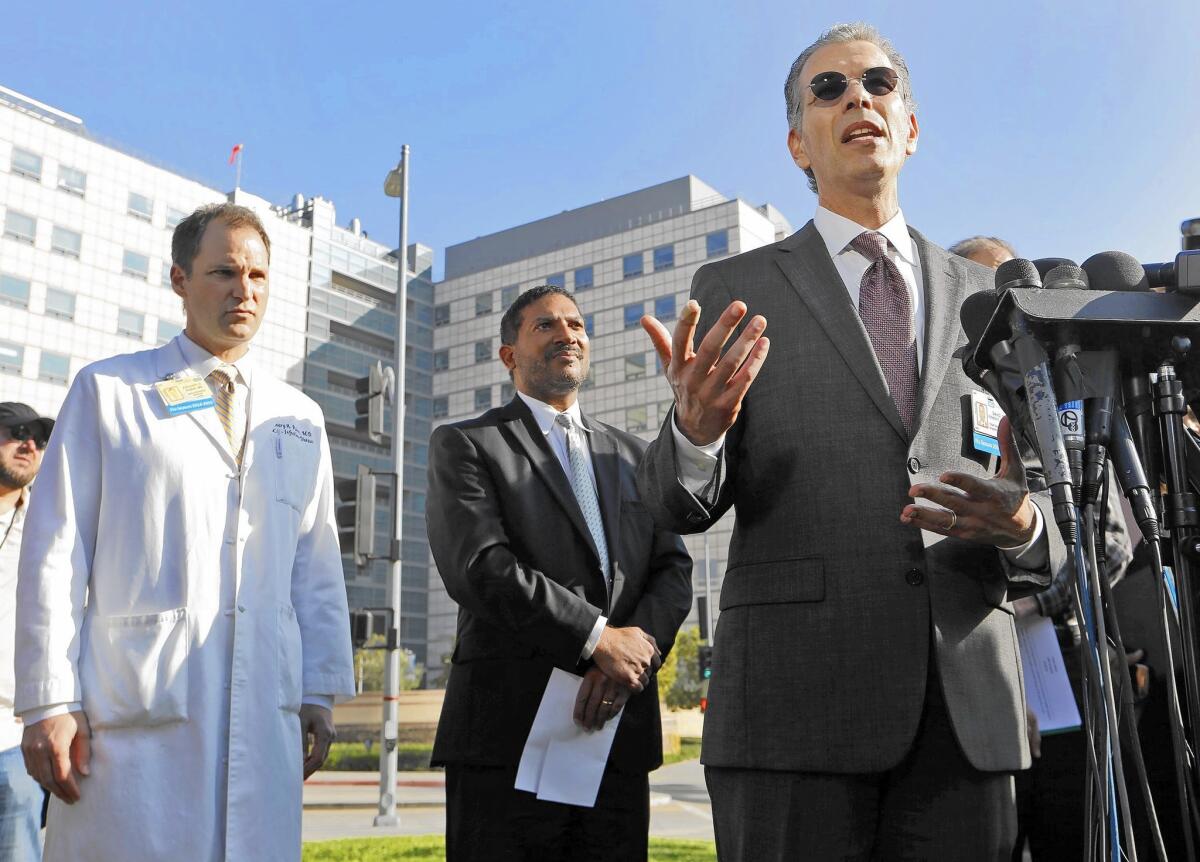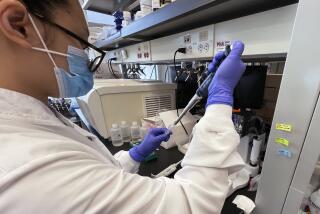FDA official casts doubt on new method to clean scopes linked to infections

A senior Food and Drug Administration official voiced reservations about the new method UCLA’s Ronald Reagan Medical Center is using to clean medical scopes linked to an outbreak of antibiotic-resistant bacteria.
The official also said Monday that the agency will require makers of any new devices to show that they can be cleaned more reliably.
In the aftermath of the outbreak at UCLA, which contributed to the deaths of two patients, university officials began sterilizing the instruments, known as duodenoscopes, using a toxic gas.
Dr. William Maisel, deputy director and chief scientist at FDA’s center for regulating medical devices, said in an interview the use of that ethylene-oxide gas was “not something that we routinely recommend.”
Although gas treatment “has helped in some cases where there have been outbreaks,” Maisel said, “there can be ethylene oxide residual levels on the products that can be harmful to patients.”
An additional problem, he said, is that using gas “can damage the scopes themselves. And so we are not, at this time, recommending routine ethylene oxide sterilization.”
In response to the FDA comments, UCLA defended its new cleaning protocol and said no new infections have occurred since it made the change.
Also Monday, Rep. Ted Lieu (D-Torrance) called on Congress to investigate what the FDA and device makers are doing to protect patients from the spread of deadly bacteria.
He said the FDA’s guidance last week to medical providers offers “no assurance that further outbreaks can be prevented.”
The scopes at issue are sensitive to heat so they can’t be sterilized like many other medical instruments.
Until now, Maisel acknowledged, the FDA has not scrutinized manufacturer-recommended protocols for decontaminating the reusable scopes. For any newly proposed scope, he said, the FDA will review the manufacturer’s basis for saying that their devices can be reused with very high confidence that no dangerous bacteria are present.
“A manufacturer must be able to demonstrate through testing that 99.9999% of bacteria are killed,” he said.
In the meantime, the agency would continue to rely on the judgment of practicing doctors, Maisel said.
“We believe that these products should be available and that healthcare providers are in the best position to make the determination about their needs.”
Maisel’s remarks provided the agency’s most extensive comments to date on the safety and use of the scopes used in ERCP, or endoscopic retrograde cholangiopancreatography.
Contaminated ERCP scopes have been linked to potential infections in 135 patients nationally from January 2013 to December 2014, according to the FDA.
In the most recent outbreak at UCLA, seven patients were infected with the superbug CRE, including the two deaths, and 179 others may have been exposed to the bacteria from October to January.
Dale Tate, a spokeswoman for UCLA, said Olympus Corp., which manufactures the scopes used at the hospital, recommends ethylene-oxide gas as an alternative for sterilization and “it is not harmful to the scopes that UCLA is using.”
She added that the hospital allows time for the gas to wear off to reduce toxicity to patients and employees. Some other U.S. hospitals have also adopted the gas method in response to the bacterial outbreaks.
Other institutions are cleaning the duodenoscopes as they did before but also putting them aside for some period of time, say 48 hours, so they can test them for bacterial growth before reusing them.
Olympus, the leading maker of duodenoscopes, said it is monitoring the issue of patient infections closely, and has provided customers with additional educational materials and video demonstrations on equipment cleaning.
Nationally, about half a million patients each year undergo ERCP, a procedure in which doctors thread the thin device down the patient’s throat to examine and treat ailments in the digestive system.
These scopes feature an “elevator channel” that doctors use to bend the device in tight spaces and allow for attachments such as catheters or guide wires.
In a safety advisory last week, the FDA warned that bacteria can survive in those tiny crevices near the tip and “effective cleaning of all areas of the duodenoscope may not be possible.”
Maisel, who has worked at the FDA since 2010, defended the agency’s overall review and supervision of duodenoscopes, which have been marketed by three companies: Olympus, Pentax and Fujifilm.
The FDA approved the first model of the scopes, made by Pentax, in 2004, according to Maisel.
That approval and all subsequent ones were made under a provision of federal law that allows device manufacturers to forgo the time and high costs of conducting clinical trials in patients if they are proposing to market a product that is substantially equivalent to one already on the market.
When a manufacturer notifies the FDA of its intent to market a device, the agency typically has 90 days to determine whether the product is “equivalent” to something already in use. The FDA’s reviews of new prescription drugs, by contrast, typically span a year or longer.
Maisel said the agency did not recognize the potential problems with contamination with the scopes until September 2013, when officials were contacted by the Centers for Disease Control and Prevention with information about infections.
He was unpreparedto say how many adverse event reports related to the scopes had been filed with the FDA as of that time. “We can try to provide you that answer,” Maisel said.
The FDA typically receives about 1 million such reports each year involving all medical devices, he said.
Despite the problems with cleaning the scopes, the FDA has maintained that withdrawing them from the market would pose more harm than good to public health.
There are no alternative devices for ERCP, according to the FDA, and the procedure “is the least invasive way of draining fluids from pancreatic and biliary ducts blocked by cancer, gallstones and other conditions.”
Twitter: @chadterhune
More to Read
Inside the business of entertainment
The Wide Shot brings you news, analysis and insights on everything from streaming wars to production — and what it all means for the future.
You may occasionally receive promotional content from the Los Angeles Times.












